TD-DFT benchmark for UV-Vis spectra of coumarin derivatives
The predictive performances for maximum absorption wavelength of the PBE, BP86, PBE0, B3LYP, M06, M06-
2X, CAM-B3LYP, LC-wPBE, APDF, wB97XD, and PW6B9D3 functionals have been benchmarked through
comparison of maximum absorption wavelength values between calculation and experiment of 21 coumarin derivatives.
For the results obtained from direct calculation by these functionals, the predictive performance decreases gradually in
the following order: B3LYP > APDF > M06 > PW6B9D3 > PBE0 > BP86 > PBE > M06-2X > CAM-B3LYP >
wB97XD > LC-wPBE. B3LYP functional gives the best predictive performance, with the smallest value of the mean
absolute error (MAE = 15 nm) and the root mean square deviation (RMSD=19 nm). When using the results obtained
through correction based on the linear correlation, the predictive performance decreases gradually in the following
order: M06-2X > PBE0, M06, PW6B9D3 > B3LYP, APDF > CAM-B3LYP, LC-wPBE, wB97XD > PBE and BP86.
M06-2X functional gives the best predictive performance, with the smallest values of MAEfix (7 nm) and RMSDfix
(9nm). The correction is very necessary because the values of the corrected maximum absorption wavelengths are
closer to the experimental maximum absorption wavelengths. The values of MAEfix and RMSDfix are much smaller than
those of MAE and RMSD.

Trang 1
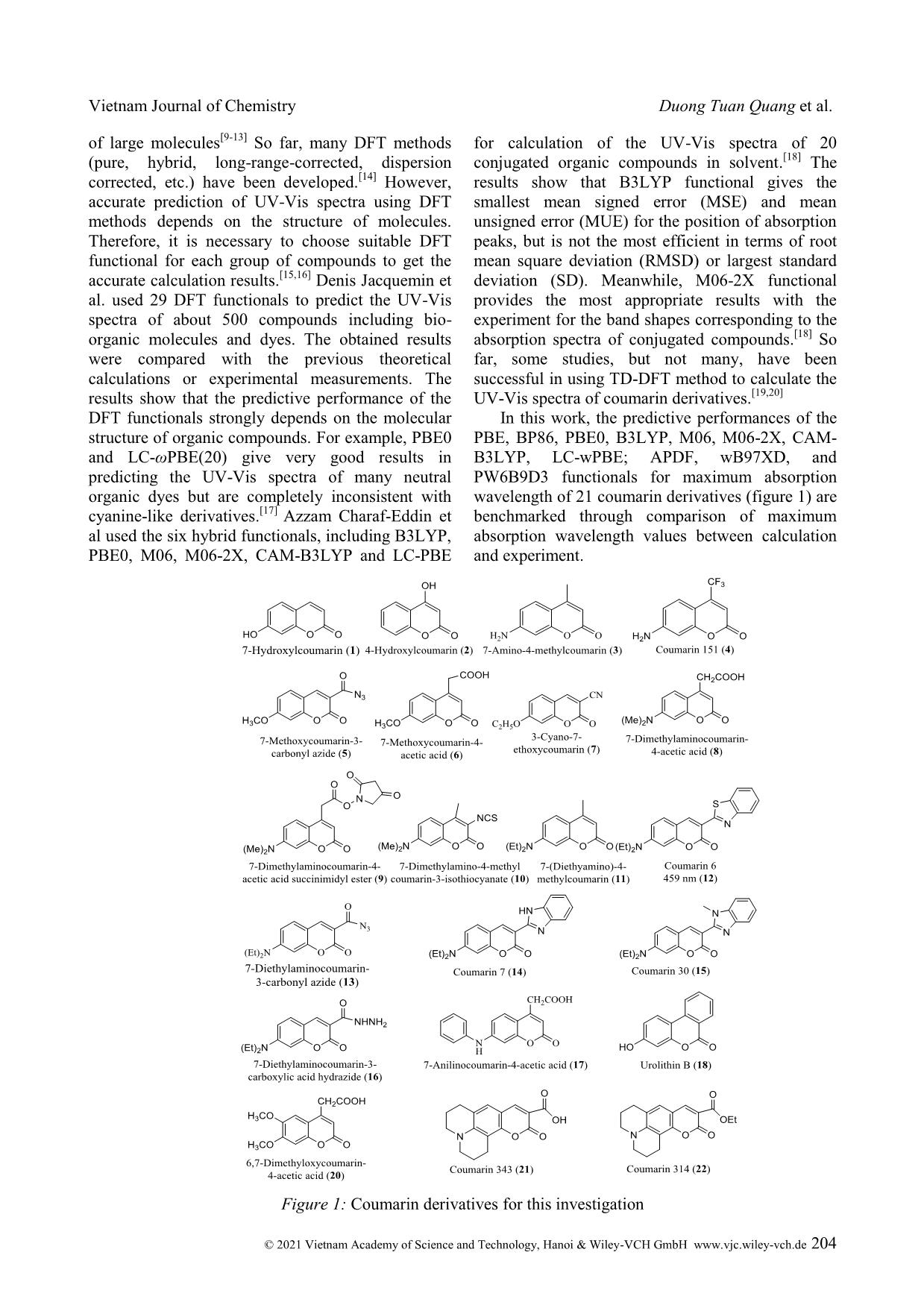
Trang 2
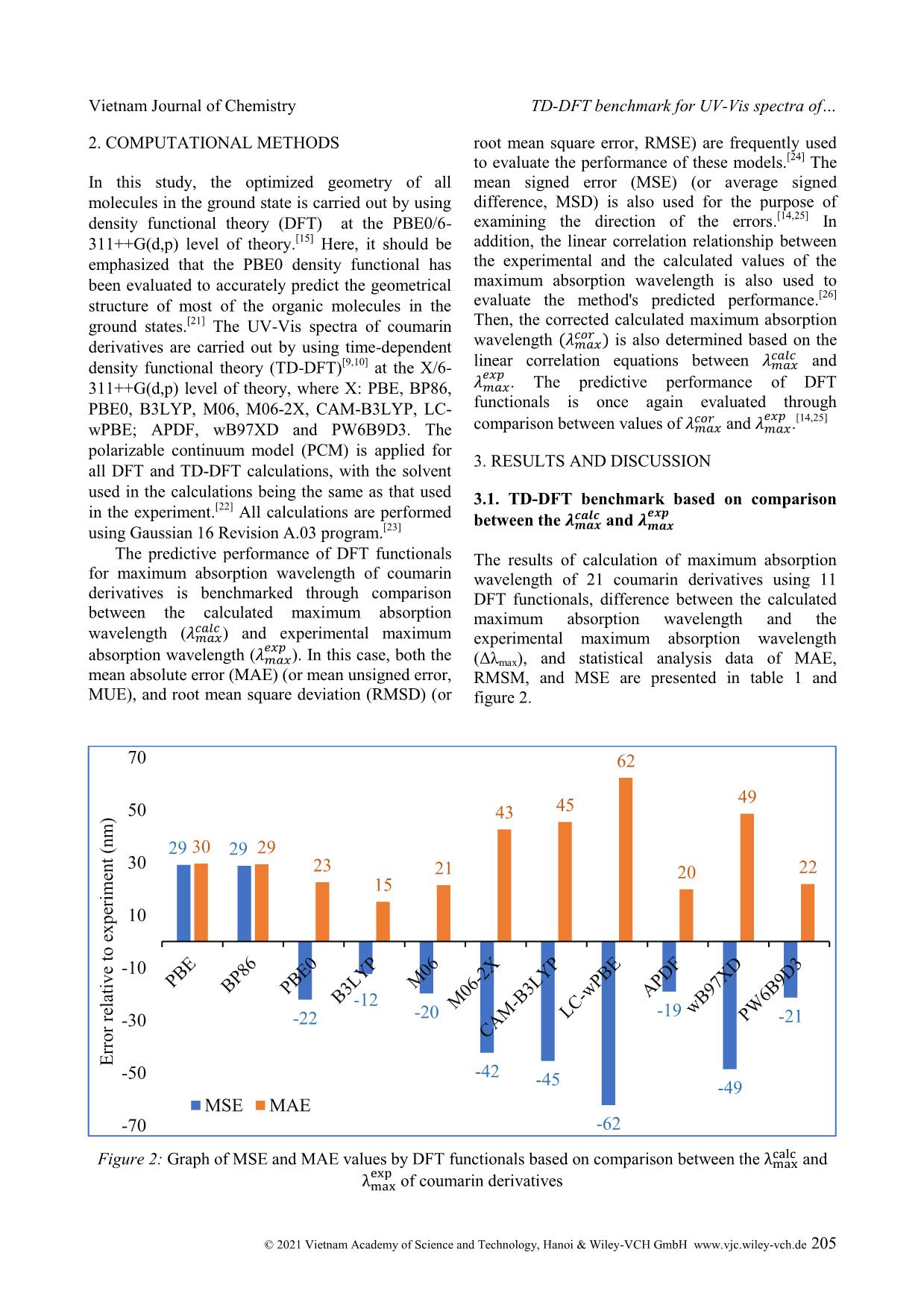
Trang 3
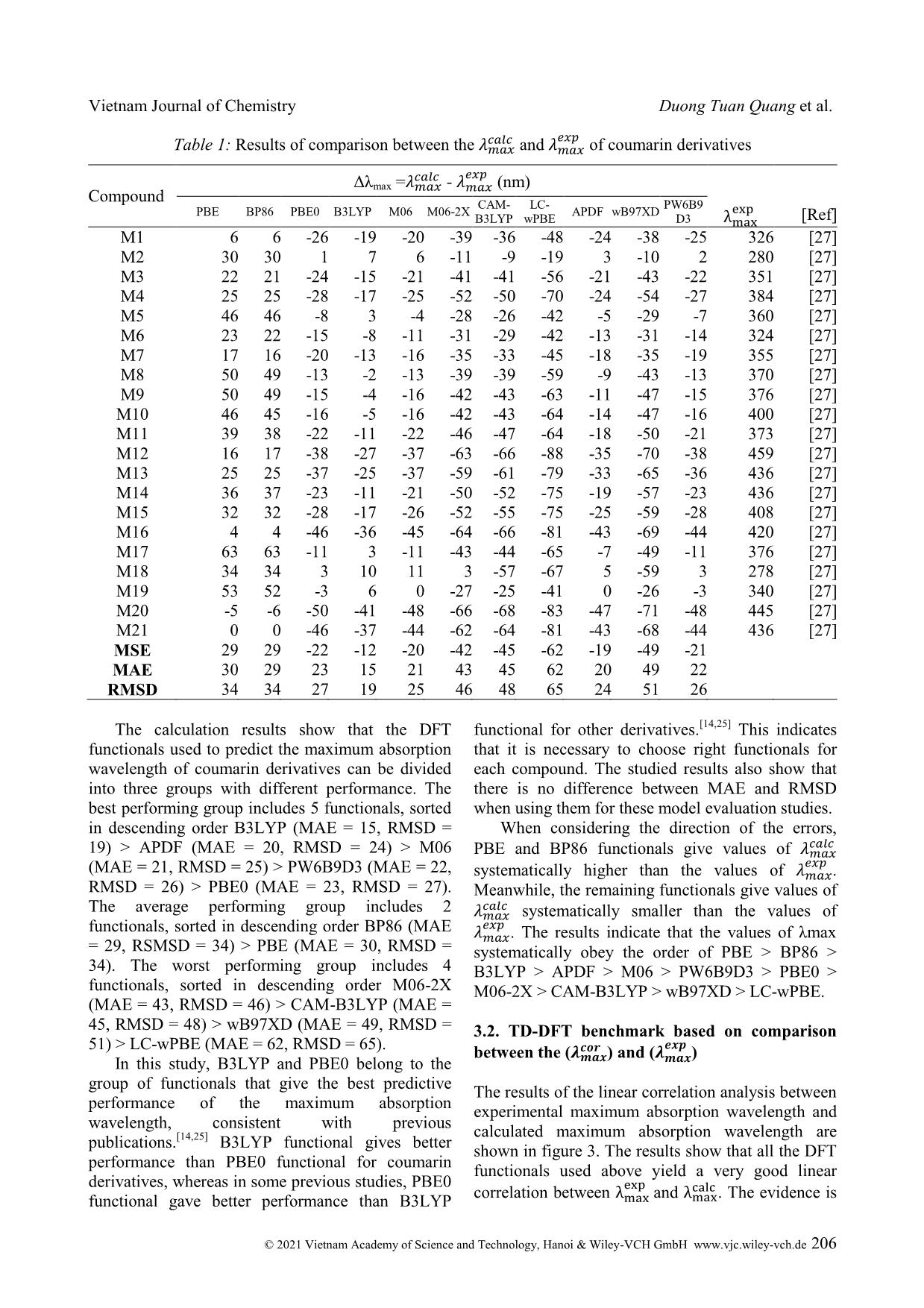
Trang 4
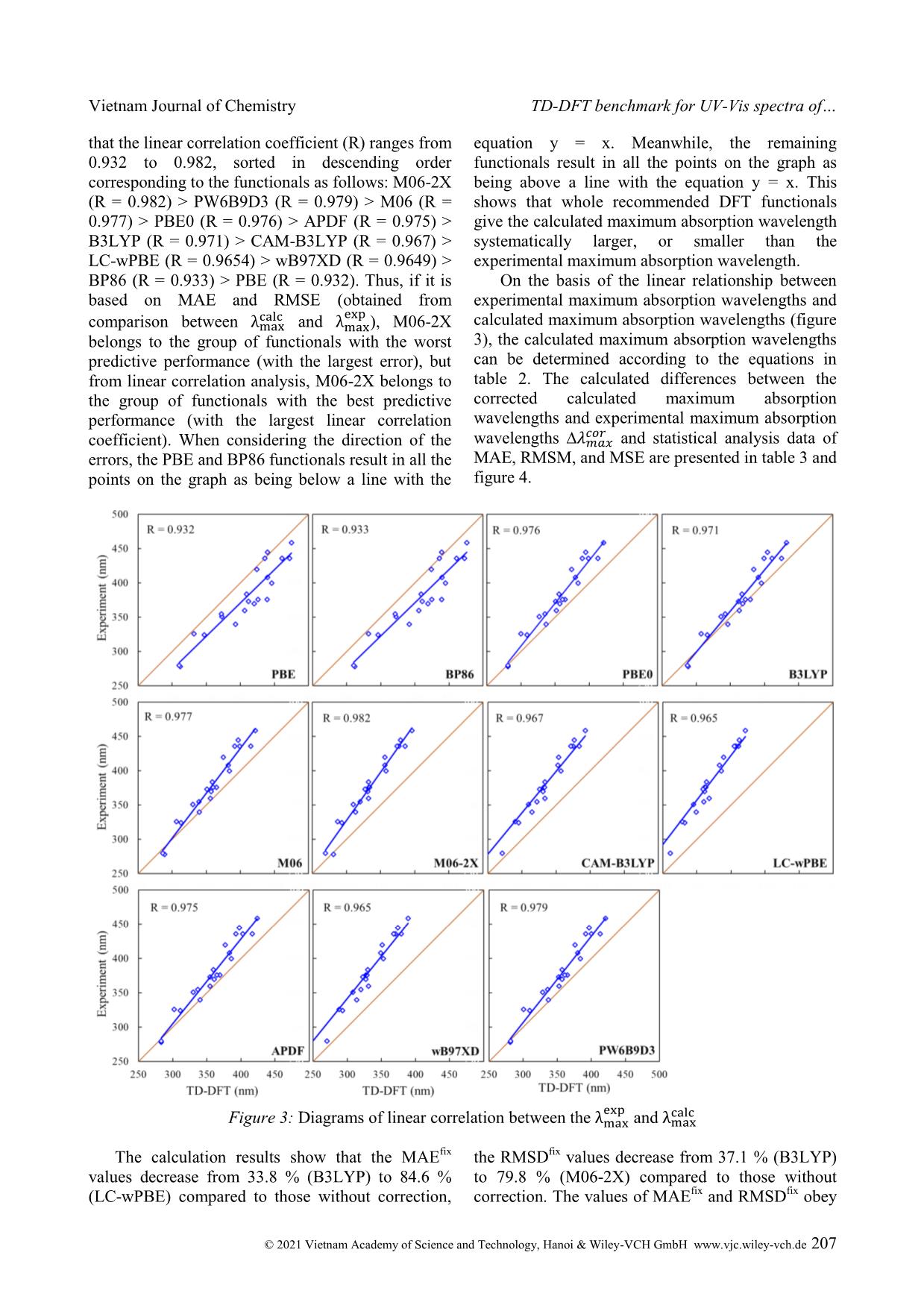
Trang 5

Trang 6
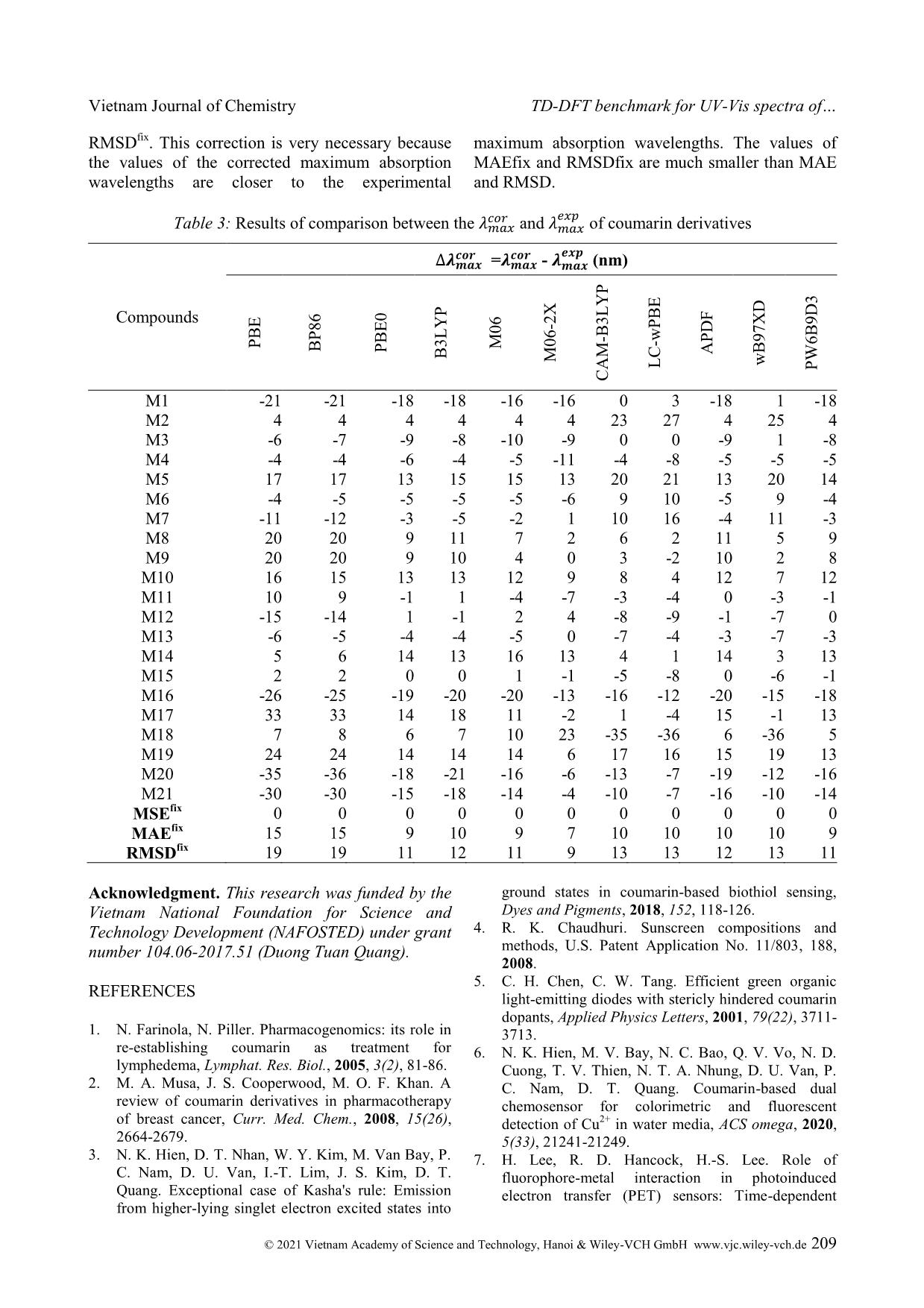
Trang 7
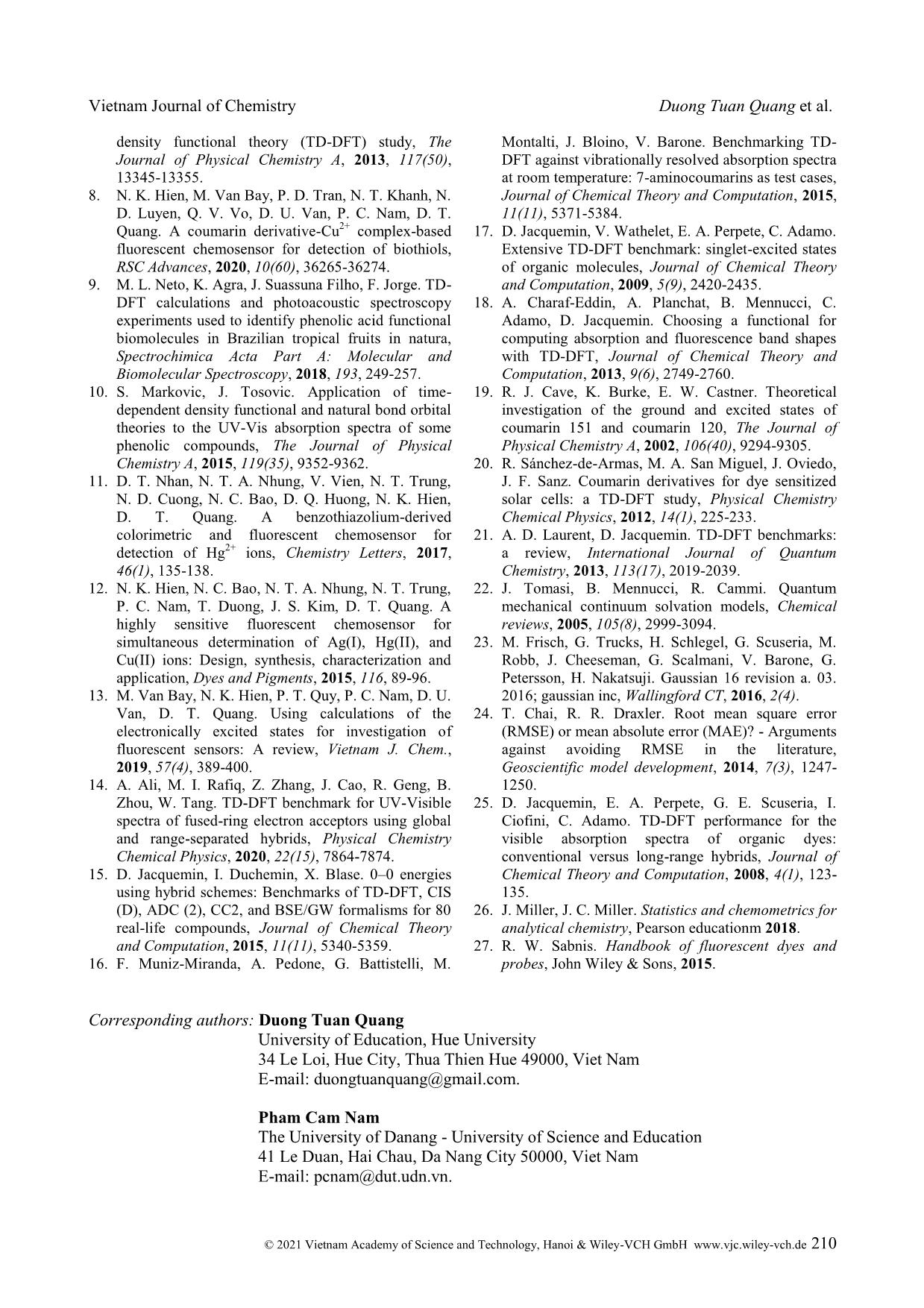
Trang 8
Tóm tắt nội dung tài liệu: TD-DFT benchmark for UV-Vis spectra of coumarin derivatives
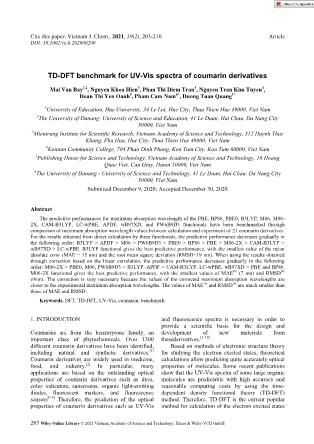
Cite this paper: Vietnam J. Chem., 2021, 59(2), 203-210 Article DOI: 10.1002/vjch.202000200 203 Wiley Online Library © 2021 Vietnam Academy of Science and Technology, Hanoi & Wiley-VCH GmbH TD-DFT benchmark for UV-Vis spectra of coumarin derivatives Mai Van Bay 1,2 , Nguyen Khoa Hien 3 , Phan Thi Diem Tran 3 , Nguyen Tran Kim Tuyen 4 , Doan Thi Yen Oanh 5 , Pham Cam Nam 6* , Duong Tuan Quang 1* 1 University of Education, Hue University, 34 Le Loi, Hue City, Thua Thien Hue 49000, Viet Nam 2 The University of Danang- University of Science and Education, 41 Le Duan, Hai Chau, Da Nang City 50000, Viet Nam 3 Mientrung Institute for Scientific Research, Vietnam Academy of Science and Technology, 312 Huynh Thuc Khang, Phu Hoa, Hue City, Thua Thien Hue 49000, Viet Nam 4 Kontum Community College, 704 Phan Dinh Phung, Kon Tum City, Kon Tum 60000, Viet Nam 5 Publishing House for Science and Technology, Vietnam Academy of Science and Technology, 18 Hoang Quoc Viet, Cau Giay, Hanoi 10000, Viet Nam 6 The University of Danang - University of Science and Technology, 41 Le Duan, Hai Chau, Da Nang City 50000, Viet Nam Submitted December 9, 2020; Accepted December 30, 2020 Abstract The predictive performances for maximum absorption wavelength of the PBE, BP86, PBE0, B3LYP, M06, M06- 2X, CAM-B3LYP, LC-wPBE, APDF, wB97XD, and PW6B9D3 functionals have been benchmarked through comparison of maximum absorption wavelength values between calculation and experiment of 21 coumarin derivatives. For the results obtained from direct calculation by these functionals, the predictive performance decreases gradually in the following order: B3LYP > APDF > M06 > PW6B9D3 > PBE0 > BP86 > PBE > M06-2X > CAM-B3LYP > wB97XD > LC-wPBE. B3LYP functional gives the best predictive performance, with the smallest value of the mean absolute error (MAE = 15 nm) and the root mean square deviation (RMSD=19 nm). When using the results obtained through correction based on the linear correlation, the predictive performance decreases gradually in the following order: M06-2X > PBE0, M06, PW6B9D3 > B3LYP, APDF > CAM-B3LYP, LC-wPBE, wB97XD > PBE and BP86. M06-2X functional gives the best predictive performance, with the smallest values of MAE fix (7 nm) and RMSD fix (9nm). The correction is very necessary because the values of the corrected maximum absorption wavelengths are closer to the experimental maximum absorption wavelengths. The values of MAE fix and RMSD fix are much smaller than those of MAE and RMSD. Keywords. DFT, TD-DFT, UV-Vis, coumarin, benchmark. 1. INTRODUCTION Coumarins are from the benzoryrone family, an important class of phytochemicals. Over 1300 different coumarin derivatives have been identified, including natural and synthetic derivatives. [1] Coumarin derivatives are widely used in medicine, food, and industry. [2] In particular, many applications are based on the outstanding optical properties of coumarin derivatives such as dyes, color indicators, sunscreens, organic light-emitting diodes, fluorescent markers, and fluorescence sensors [3-6] Therefore, the prediction of the optical properties of coumarin derivatives such as UV-Vis and fluorescence spectra is necessary in order to provide a scientific basis for the design and development of new materials from thesederivatives. [3,7,8] Based on methods of electronic structure theory for studying the electron excited states, theoretical calculations allow predicting quite accurately optical properties of molecules. Some recent publications show that the UV-Vis spectra of some large organic molecules are predictable with high accuracy and reasonable computing costs by using the time- dependent density functional theory (TD-DFT) method. Therefore, TD-DFT is the current popular method for calculation of the electron excited states Vietnam Journal of Chemistry Duong Tuan Quang et al. © 2021 Vietnam Academy of Science and Technology, Hanoi & Wiley-VCH GmbH www.vjc.wiley-vch.de 204 of large molecules [9-13] So far, many DFT methods (pure, hybrid, long-range-corrected, dispersion corrected, etc.) have been developed. [14] However, accurate prediction of UV-Vis spectra using DFT methods depends on the structure of molecules. Therefore, it is necessary to choose suitable DFT functional for each group of compounds to get the accurate calculation results. [15,16] Denis Jacquemin et al. used 29 DFT functionals to predict the UV-Vis spectra of about 500 compounds including bio- organic molecules and dyes. The obtained results were compared with the previous theoretical calculations or experimental measurements. The results show that the predictive performance of the DFT functionals strongly depends on the molecular structure of organic compounds. For example, PBE0 and LC-ωPBE(20) give very good results in predicting the UV-Vis spectra of many neutral organic dyes but are completely inconsistent with cyanine-like derivatives. [17] Azzam Charaf-Eddin et al used the six hybrid functionals, including B3LYP, PBE0, M06, M06-2X, CAM-B3LYP and LC-PBE for calculation of the UV-Vis spectra of 20 conjugated organic compounds in solvent. [18] The results show that B3LYP functional gives the smallest mean signed error (MSE) and mean unsigned error (MUE) for the position of absorption peaks, but is not the most efficient in terms of root mean square deviation (RMSD) or largest standard deviation (SD). Meanwhile, M06-2X functional provides the most appropriate results with the experiment for the band shapes corresponding to the absorption spectra of conjugated compounds. [18] So far, some studies, but not many, have been successful in using TD-DFT method to calculate the UV-Vis spectra of coumarin derivatives. [19,20] In ... ssary to choose right functionals for each compound. The studied results also show that there is no difference between MAE and RMSD when using them for these model evaluation studies. When considering the direction of the errors, PBE and BP86 functionals give values of systematically higher than the values of . Meanwhile, the remaining functionals give values of systematically smaller than the values of . The results indicate that the values of λmax systematically obey the order of PBE > BP86 > B3LYP > APDF > M06 > PW6B9D3 > PBE0 > M06-2X > CAM-B3LYP > wB97XD > LC-wPBE. 3.2. TD-DFT benchmark based on comparison between the ( ) and ( ) The results of the linear correlation analysis between experimental maximum absorption wavelength and calculated maximum absorption wavelength are shown in figure 3. The results show that all the DFT functionals used above yield a very good linear correlation between and . The evidence is Vietnam Journal of Chemistry TD-DFT benchmark for UV-Vis spectra of © 2021 Vietnam Academy of Science and Technology, Hanoi & Wiley-VCH GmbH www.vjc.wiley-vch.de 207 that the linear correlation coefficient (R) ranges from 0.932 to 0.982, sorted in descending order corresponding to the functionals as follows: M06-2X (R = 0.982) > PW6B9D3 (R = 0.979) > M06 (R = 0.977) > PBE0 (R = 0.976) > APDF (R = 0.975) > B3LYP (R = 0.971) > CAM-B3LYP (R = 0.967) > LC-wPBE (R = 0.9654) > wB97XD (R = 0.9649) > BP86 (R = 0.933) > PBE (R = 0.932). Thus, if it is based on MAE and RMSE (obtained from comparison between and ), M06-2X belongs to the group of functionals with the worst predictive performance (with the largest error), but from linear correlation analysis, M06-2X belongs to the group of functionals with the best predictive performance (with the largest linear correlation coefficient). When considering the direction of the errors, the PBE and BP86 functionals result in all the points on the graph as being below a line with the equation y = x. Meanwhile, the remaining functionals result in all the points on the graph as being above a line with the equation y = x. This shows that whole recommended DFT functionals give the calculated maximum absorption wavelength systematically larger, or smaller than the experimental maximum absorption wavelength. On the basis of the linear relationship between experimental maximum absorption wavelengths and calculated maximum absorption wavelengths (figure 3), the calculated maximum absorption wavelengths can be determined according to the equations in table 2. The calculated differences between the corrected calculated maximum absorption wavelengths and experimental maximum absorption wavelengths ∆ and statistical analysis data of MAE, RMSM, and MSE are presented in table 3 and figure 4. Figure 3: Diagrams of linear correlation between the and The calculation results show that the MAE fix values decrease from 33.8 % (B3LYP) to 84.6 % (LC-wPBE) compared to those without correction, the RMSD fix values decrease from 37.1 % (B3LYP) to 79.8 % (M06-2X) compared to those without correction. The values of MAE fix and RMSD fix obey Vietnam Journal of Chemistry Duong Tuan Quang et al. © 2021 Vietnam Academy of Science and Technology, Hanoi & Wiley-VCH GmbH www.vjc.wiley-vch.de 208 a M06-2X (MAE fix = 7, RMSD fix = 9) < PBE0, M06, PW6B9D3 (MAE fix = 9, RMSD fix = 11) < B3LYP, APDF (MAE fix = 10, RMSD fix = 12) < CAM- B3LYP, LC-wPBE, wB97XD (MAE fix = 10, RMSD fix = 13) < PBE, BP86 (MAE fix = 15, RMSD fix = 19) order. These results indicate that M06-2X functional gives the best predictive performance for maximum absorption wavelength of coumarin derivatives. These results show the importance of correcting the calculated results for the maximum absorption wavelength of coumarin derivatives by TD-DFT, in order to obtain the values of corrected maximum absorption wavelength that are closer to experimental maximum absorption wavelengths. Table 2: Equations for calculation of according to of DFT functionals Functionals Equations PBE - 17.802 BP86 - 16.424 PBE0 - 66.822 B3LYP - 59.939 M06 - 89.388 M06-2X - 93.783 CAM-B3LYP - 24.851 LC-wPBE - 31.871 APDF - 65.196 wB97XD - 28.301 PW6B9D3 - 69.671 Figure 4: Graph of MAE values with/without linear fixing 4. CONCLUSION The predictive performances of the PBE, BP86, PBE0, B3LYP, M06, M06-2X, CAM-B3LYP, LC- wPBE; APDF, wB97XD, and PW6B9D3 functionals for maximum absorption wavelength have been benchmarked through comparison of maximum absorption wavelength values between calculation and experiment of 21 coumarin derivatives. The results show that all the DFT functionals yield a very good linear correlation between and . For the results obtained from direct calculation by functionals, B3LYP functional gives the best predictive performance of the maximum absorption wavelengths, with the smallest values of MAE and RMSD. However, when using the results obtained through correction based on the linear correlation between the experimental maximum absorption wavelengths and the calculated maximum absorption wavelengths, the M06-2X functional gives the best predictive performance, with the smallest values of MAE fix and 30 29 23 15 21 43 45 62 20 49 22 15 15 9 10 9 7 10 10 9 10 9 0 10 20 30 40 50 60 70 E rr o r re la ti v e to e x p er im en t (n m ) MAE without fixing MAE with linear fixing Vietnam Journal of Chemistry TD-DFT benchmark for UV-Vis spectra of © 2021 Vietnam Academy of Science and Technology, Hanoi & Wiley-VCH GmbH www.vjc.wiley-vch.de 209 RMSD fix . This correction is very necessary because the values of the corrected maximum absorption wavelengths are closer to the experimental maximum absorption wavelengths. The values of MAEfix and RMSDfix are much smaller than MAE and RMSD. Table 3: Results of comparison between the and of coumarin derivatives Compounds = - (nm) P B E B P 8 6 P B E 0 B 3 L Y P M 0 6 M 0 6 -2 X C A M -B 3 L Y P L C -w P B E A P D F w B 9 7 X D P W 6 B 9 D 3 M1 -21 -21 -18 -18 -16 -16 0 3 -18 1 -18 M2 4 4 4 4 4 4 23 27 4 25 4 M3 -6 -7 -9 -8 -10 -9 0 0 -9 1 -8 M4 -4 -4 -6 -4 -5 -11 -4 -8 -5 -5 -5 M5 17 17 13 15 15 13 20 21 13 20 14 M6 -4 -5 -5 -5 -5 -6 9 10 -5 9 -4 M7 -11 -12 -3 -5 -2 1 10 16 -4 11 -3 M8 20 20 9 11 7 2 6 2 11 5 9 M9 20 20 9 10 4 0 3 -2 10 2 8 M10 16 15 13 13 12 9 8 4 12 7 12 M11 10 9 -1 1 -4 -7 -3 -4 0 -3 -1 M12 -15 -14 1 -1 2 4 -8 -9 -1 -7 0 M13 -6 -5 -4 -4 -5 0 -7 -4 -3 -7 -3 M14 5 6 14 13 16 13 4 1 14 3 13 M15 2 2 0 0 1 -1 -5 -8 0 -6 -1 M16 -26 -25 -19 -20 -20 -13 -16 -12 -20 -15 -18 M17 33 33 14 18 11 -2 1 -4 15 -1 13 M18 7 8 6 7 10 23 -35 -36 6 -36 5 M19 24 24 14 14 14 6 17 16 15 19 13 M20 -35 -36 -18 -21 -16 -6 -13 -7 -19 -12 -16 M21 -30 -30 -15 -18 -14 -4 -10 -7 -16 -10 -14 MSE fix 0 0 0 0 0 0 0 0 0 0 0 MAE fix 15 15 9 10 9 7 10 10 10 10 9 RMSD fix 19 19 11 12 11 9 13 13 12 13 11 Acknowledgment. This research was funded by the Vietnam National Foundation for Science and Technology Development (NAFOSTED) under grant number 104.06-2017.51 (Duong Tuan Quang). REFERENCES 1. N. Farinola, N. Piller. Pharmacogenomics: its role in re-establishing coumarin as treatment for lymphedema, Lymphat. Res. Biol., 2005, 3(2), 81-86. 2. M. A. Musa, J. S. Cooperwood, M. O. F. Khan. A review of coumarin derivatives in pharmacotherapy of breast cancer, Curr. Med. Chem., 2008, 15(26), 2664-2679. 3. N. K. Hien, D. T. Nhan, W. Y. Kim, M. Van Bay, P. C. Nam, D. U. Van, I.-T. Lim, J. S. Kim, D. T. Quang. Exceptional case of Kasha's rule: Emission from higher-lying singlet electron excited states into ground states in coumarin-based biothiol sensing, Dyes and Pigments, 2018, 152, 118-126. 4. R. K. Chaudhuri. Sunscreen compositions and methods, U.S. Patent Application No. 11/803, 188, 2008. 5. C. H. Chen, C. W. Tang. Efficient green organic light-emitting diodes with stericly hindered coumarin dopants, Applied Physics Letters, 2001, 79(22), 3711- 3713. 6. N. K. Hien, M. V. Bay, N. C. Bao, Q. V. Vo, N. D. Cuong, T. V. Thien, N. T. A. Nhung, D. U. Van, P. C. Nam, D. T. Quang. Coumarin-based dual chemosensor for colorimetric and fluorescent detection of Cu 2+ in water media, ACS omega, 2020, 5(33), 21241-21249. 7. H. Lee, R. D. Hancock, H.-S. Lee. Role of fluorophore-metal interaction in photoinduced electron transfer (PET) sensors: Time-dependent Vietnam Journal of Chemistry Duong Tuan Quang et al. © 2021 Vietnam Academy of Science and Technology, Hanoi & Wiley-VCH GmbH www.vjc.wiley-vch.de 210 density functional theory (TD-DFT) study, The Journal of Physical Chemistry A, 2013, 117(50), 13345-13355. 8. N. K. Hien, M. Van Bay, P. D. Tran, N. T. Khanh, N. D. Luyen, Q. V. Vo, D. U. Van, P. C. Nam, D. T. Quang. A coumarin derivative-Cu 2+ complex-based fluorescent chemosensor for detection of biothiols, RSC Advances, 2020, 10(60), 36265-36274. 9. M. L. Neto, K. Agra, J. Suassuna Filho, F. Jorge. TD- DFT calculations and photoacoustic spectroscopy experiments used to identify phenolic acid functional biomolecules in Brazilian tropical fruits in natura, Spectrochimica Acta Part A: Molecular and Biomolecular Spectroscopy, 2018, 193, 249-257. 10. S. Markovic, J. Tosovic. Application of time- dependent density functional and natural bond orbital theories to the UV-Vis absorption spectra of some phenolic compounds, The Journal of Physical Chemistry A, 2015, 119(35), 9352-9362. 11. D. T. Nhan, N. T. A. Nhung, V. Vien, N. T. Trung, N. D. Cuong, N. C. Bao, D. Q. Huong, N. K. Hien, D. T. Quang. A benzothiazolium-derived colorimetric and fluorescent chemosensor for detection of Hg 2+ ions, Chemistry Letters, 2017, 46(1), 135-138. 12. N. K. Hien, N. C. Bao, N. T. A. Nhung, N. T. Trung, P. C. Nam, T. Duong, J. S. Kim, D. T. Quang. A highly sensitive fluorescent chemosensor for simultaneous determination of Ag(I), Hg(II), and Cu(II) ions: Design, synthesis, characterization and application, Dyes and Pigments, 2015, 116, 89-96. 13. M. Van Bay, N. K. Hien, P. T. Quy, P. C. Nam, D. U. Van, D. T. Quang. Using calculations of the electronically excited states for investigation of fluorescent sensors: A review, Vietnam J. Chem., 2019, 57(4), 389-400. 14. A. Ali, M. I. Rafiq, Z. Zhang, J. Cao, R. Geng, B. Zhou, W. Tang. TD-DFT benchmark for UV-Visible spectra of fused-ring electron acceptors using global and range-separated hybrids, Physical Chemistry Chemical Physics, 2020, 22(15), 7864-7874. 15. D. Jacquemin, I. Duchemin, X. Blase. 0–0 energies using hybrid schemes: Benchmarks of TD-DFT, CIS (D), ADC (2), CC2, and BSE/GW formalisms for 80 real-life compounds, Journal of Chemical Theory and Computation, 2015, 11(11), 5340-5359. 16. F. Muniz-Miranda, A. Pedone, G. Battistelli, M. Montalti, J. Bloino, V. Barone. Benchmarking TD- DFT against vibrationally resolved absorption spectra at room temperature: 7-aminocoumarins as test cases, Journal of Chemical Theory and Computation, 2015, 11(11), 5371-5384. 17. D. Jacquemin, V. Wathelet, E. A. Perpete, C. Adamo. Extensive TD-DFT benchmark: singlet-excited states of organic molecules, Journal of Chemical Theory and Computation, 2009, 5(9), 2420-2435. 18. A. Charaf-Eddin, A. Planchat, B. Mennucci, C. Adamo, D. Jacquemin. Choosing a functional for computing absorption and fluorescence band shapes with TD-DFT, Journal of Chemical Theory and Computation, 2013, 9(6), 2749-2760. 19. R. J. Cave, K. Burke, E. W. Castner. Theoretical investigation of the ground and excited states of coumarin 151 and coumarin 120, The Journal of Physical Chemistry A, 2002, 106(40), 9294-9305. 20. R. Sánchez-de-Armas, M. A. San Miguel, J. Oviedo, J. F. Sanz. Coumarin derivatives for dye sensitized solar cells: a TD-DFT study, Physical Chemistry Chemical Physics, 2012, 14(1), 225-233. 21. A. D. Laurent, D. Jacquemin. TD-DFT benchmarks: a review, International Journal of Quantum Chemistry, 2013, 113(17), 2019-2039. 22. J. Tomasi, B. Mennucci, R. Cammi. Quantum mechanical continuum solvation models, Chemical reviews, 2005, 105(8), 2999-3094. 23. M. Frisch, G. Trucks, H. Schlegel, G. Scuseria, M. Robb, J. Cheeseman, G. Scalmani, V. Barone, G. Petersson, H. Nakatsuji. Gaussian 16 revision a. 03. 2016; gaussian inc, Wallingford CT, 2016, 2(4). 24. T. Chai, R. R. Draxler. Root mean square error (RMSE) or mean absolute error (MAE)? - Arguments against avoiding RMSE in the literature, Geoscientific model development, 2014, 7(3), 1247- 1250. 25. D. Jacquemin, E. A. Perpete, G. E. Scuseria, I. Ciofini, C. Adamo. TD-DFT performance for the visible absorption spectra of organic dyes: conventional versus long-range hybrids, Journal of Chemical Theory and Computation, 2008, 4(1), 123- 135. 26. J. Miller, J. C. Miller. Statistics and chemometrics for analytical chemistry, Pearson educationm 2018. 27. R. W. Sabnis. Handbook of fluorescent dyes and probes, John Wiley & Sons, 2015. Corresponding authors: Duong Tuan Quang University of Education, Hue University 34 Le Loi, Hue City, Thua Thien Hue 49000, Viet Nam E-mail: duongtuanquang@gmail.com. Pham Cam Nam The University of Danang - University of Science and Education 41 Le Duan, Hai Chau, Da Nang City 50000, Viet Nam E-mail: pcnam@dut.udn.vn.
File đính kèm:
 td_dft_benchmark_for_uv_vis_spectra_of_coumarin_derivatives.pdf
td_dft_benchmark_for_uv_vis_spectra_of_coumarin_derivatives.pdf

